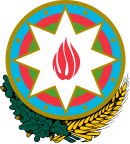مێژووی کۆماری ئازەربایجان

ئازەربایجان وڵاتێکە لە ناوچەی قەفقاز و لە باشووری ڕۆژھەڵاتی ئەورووپا. ئەم وڵاتە لە ڕۆژھەڵاتەوە ھاوسنوورە لەگەڵ دەریای خەزەر و لە باکوورەوە لەگەڵ ناوچەی داغستانی ڕووسیا، لە باکووری ڕۆژاواوە لەگەڵ جۆرجیا، لە باشووری ڕۆژاواوە تورکیا و ئەرمینیا و لە باشوورەوە ئێران ھاوسنوورە. ئەم وڵاتە زێدی زۆرێک لە نەتەوەکانە کە زۆربەیان ئازەرین. ئەوان نەتەوەیەکی تورک زمانن کە ٩ ملیۆن کەس لە ئازەربایجان لەخۆدەگرن. لە سەردەمی مادەکان و پاشان فارسەکاندا، زۆرێک لە قەوقازییەکان بوونە ئایینی زەردەشتی و دواتر پەیوەندییان بە ئایینی مەسیحییەوە کرد، کە پێش ھێرشی عەرەبە موسڵمانەکان و لەوەش گرنگتر ھێرشی تورکە موسڵمانەکان بوو. بۆ ئەوەی بتوانن بچنە ناو ئەو خاکانەوە، ھۆزە تورکە موسڵمانەکان بوونە زاڵبوون بەسەر گرووپە جیھادییەکان کە بە غازییەکان ناسراون، کە بۆ ماوەی سەدان ساڵ لە شەڕی دژی مەسیحییەکان و بیزەنتین داگیریان کرد و لە کۆتاییدا بوونە ھۆی زیادبوونی ژمارەی دانیشتووانی تورک.[١] دوابەدوای شەڕەکانی نێوان ئێران و ڕووسیا لە نێوان ساڵانی ١٨١٣ بۆ ١٨٢٨، شانشینی قاجار ناچار بوو ھەموو ناوچەکانی قەفقاز بداتە دەست ئیمپراتۆرییەتی ڕووسیا و پەیماننامەکانی گۆلستان لە ساڵی ١٨١٣ و تورکمانچای لە ساڵی ١٨٢٨ سنوورەکانی نێوان ئێران و ڕووسیا دیاری کرد.[٢][٣] ئەم ناوچەیە لە باکووری ڕووباری ئاراس، لە کۆماری ئازەربایجانی ئەمڕۆدا، بەشێک لە ئێران بووە تا داگیرکردنی لەلایەن ڕووسیا لە سەدەی نۆزدەھەمدا.[٤][٥][٦][٧][٨][٩] ئێران لە پەیمانی تورکمانچایدا دانی بە سەروەری ڕووسیادا نا بەسەر خانەاتی یەریڤان و خانەیەتی نەخچیڤان و باقی خانەنشینی لانکەران کە ناوچەکانی باشووری ئازەربایجانی لەخۆگرتبوو و پێش تورکمانچای لەدەستی ئێراندا بوو.[١٠]
ئازەربایجان بۆ ماوەی زیاتر لە ٨٠ ساڵ لەژێر دەسەڵاتی ڕووسەکاندا بوو تا ساڵی ١٩١٨، ئەوکاتە دوای شۆڕشی ڕووسیا ئازەربایجان سەربەخۆ بوو و کۆماری ئازەربایجانی دیموکراتی دامەزرا. ناوی ئازەربایجان کە لەلایەن ڕێبەری پارتی یەکسانی، محەممەد ئەمین ڕەسوڵزادە ناسرابوو، بە ھۆکاری سیاسی[١١][١٢] پێش دامەزراندنی کۆمار بۆ دانپێدانانی ناوچە دراوسێکانی باکووری ڕۆژاوا و ڕۆژھەڵاتی ئێران بەکارھێنرا.[١٣][١٤][١٥] ئەم وڵاتە لە ساڵی ١٩٢٠ لەلایەن ھێزەکانی سۆڤیەت داگیرکرا و لەژێر ھەژموونی کۆمۆنیزمدا بوو تا ڕووخانی یەکێتی سۆڤیەت لە ساڵی ١٩٩١ و دواجار کۆماری ئازەربایجانی مۆدێرن دروست بوو.
سەردەمی پێش مێژوو[دەستکاری]
مێژووی بوونی مرۆڤ لە کۆماری ئازەربایجان دەگەڕێتەوە بۆ ھەزاران ساڵ پێش ئێستا. ھەڵکۆڵینەکانی دەشکەوتی ئازیخەکان لە بەشی فۆزولی بوونی شوێنەواری ژیانی مرۆڤەکان دەردەخەن کە مێژووەکەی دەگەڕێتەوە بۆ ٣٥٠ بۆ ٤٠٠ ھەزار ساڵ پێش ئێستا.[١٦] ھەروەھا پترۆگلیفەکانی قوبوستان مێژوویەکی ١٢ ھەزار ساڵەیان ھەیە. لە سەدەی نۆی پێش زایین، سکیتییەکان لەم ناوچەیەدا نیشتەجێ بوون کە ئێستا بە کۆماری ئازەربایجان ناودەبرێت. دوای ئەوان مادەکان و پاشان ھەخامەنییەکان بە سەرکردایەتی کوروش حوکمڕانی ناوچەکەیان کرد. لەگەڵ ھێرشی ئەسکەندەر، قۆناغی حوکمڕانی فەرمانڕەوا وابەستەکانی لە ناوچەکەدا دەستی پێکرد، بەڵام لە ھەندێک قۆناغدا فەرمانڕەوا ناوخۆیییەکان بە باجدان حکوومەتی ناوخۆیی خۆیان دامەزراند.[١٧]
سەرچاوەکان[دەستکاری]
- ^ Seyahatname by Evliya Çelebi (1611–1682)
- ^ Harcave, Sidney (1968). Russia: A History: Sixth Edition. Lippincott. p. 267.
- ^ Mojtahed-Zadeh, Pirouz (2007). Boundary Politics and International Boundaries of Iran: A Study of the Origin, Evolution, and Implications of the Boundaries of Modern Iran with Its 15 Neighbors in the Middle East by a Number of Renowned Experts in the Field. Universal. p. 372. ISBN 1-58112-933-5.
- ^ Swietochowski, Tadeusz (1995). Russia and Azerbaijan: A Borderland in Transition. Columbia University Press. pp. 69, 133. ISBN 978-0-231-07068-3.
- ^ L. Batalden, Sandra (1997). The newly independent states of Eurasia: handbook of former Soviet republics. Greenwood Publishing Group. p. 98. ISBN 978-0-89774-940-4.
- ^ E. Ebel, Robert, Menon, Rajan (2000). Energy and conflict in Central Asia and the Caucasus. Rowman & Littlefield. p. 181. ISBN 978-0-7425-0063-1.
- ^ Andreeva, Elena (2010). Russia and Iran in the great game: travelogues and orientalism (reprint ed.). Taylor & Francis. p. 6. ISBN 978-0-415-78153-4.
- ^ Çiçek, Kemal, Kuran, Ercüment (2000). The Great Ottoman-Turkish Civilisation. University of Michigan. ISBN 978-975-6782-18-7.
- ^ Ernest Meyer, Karl, Blair Brysac, Shareen (2006). Tournament of Shadows: The Great Game and the Race for Empire in Central Asia. Basic Books. p. 66. ISBN 978-0-465-04576-1.[بەستەری مردوو]
- ^ Timothy C. Dowling Russia at War: From the Mongol Conquest to Afghanistan, Chechnya, and Beyond pp 728–729 ABC-CLIO, 2 dec. 2014 ISBN 1598849484
- ^ Yilmaz, Harun (2015). National Identities in Soviet Historiography: The Rise of Nations Under Stalin. Routledge. p. 21. ISBN 978-1-317-59664-6.
On May 27, the Democratic Republic of Azerbaijan (DRA) was declared with Ottoman military support. The rulers of the DRA refused to identify themselves as [Transcaucasian] Tatar, which they rightfully considered to be a Russian colonial definition. (...) Neighboring Iran did not welcome did not welcome the DRA's adoptation of the name of "Azerbaijan" for the country because it could also refer to Iranian Azerbaijan and implied a territorial claim.
- ^ Barthold, Vasily (1963). Sochineniya, vol II/1. Moscow. p. 706.
(...) whenever it is necessary to choose a name that will encompass all regions of the republic of Azerbaijan, name Arran can be chosen. But the term Azerbaijan was chosen because when the Azerbaijan republic was created, it was assumed that this and the Persian Azerbaijan will be one entity, because the population of both has a big similarity. On this basis, the word Azerbaijan was chosen. Of course right now when the word Azerbaijan is used, it has two meanings as Persian Azerbaijan and as a republic, its confusing and a question rises as to which Azerbaijan is talked about.
- ^ Atabaki, Touraj (2000). Azerbaijan: Ethnicity and the Struggle for Power in Iran. I.B.Tauris. p. 25. ISBN 978-1-86064-554-9.
- ^ Dekmejian, R. Hrair; Simonian, Hovann H. (2003). Troubled Waters: The Geopolitics of the Caspian Region. I.B. Tauris. p. 60. ISBN 978-1-86064-922-6.
Until 1918, when the Musavat regime decided to name the newly independent state Azerbaijan, this designation had been used exclusively to identify the Iranian province of Azerbaijan.
- ^ Rezvani, Babak (2014). Ethno-territorial conflict and coexistence in the caucasus, Central Asia and Fereydan: academisch proefschrift. Amsterdam: Amsterdam University Press. p. 356. ISBN 978-9048519286.
The region to the north of the river Araxes was not called Azerbaijan prior to 1918, unlike the region in northwestern Iran that has been called since so long ago.
- ^ Jawbones and Dragon Legends: Azerbaijan's Prehistoric Azikh Cave by Dr. Arif Mustafayev
- ^ https://archive.today/20121212005248/lcweb2.loc.gov/cgi-bin/query/r?frd/cstdy:@field(DOCID+az0014)
| کۆمنزی ویکیمیدیا، میدیای پەیوەندیدار بە مێژووی کۆماری ئازەربایجان تێدایە. |
